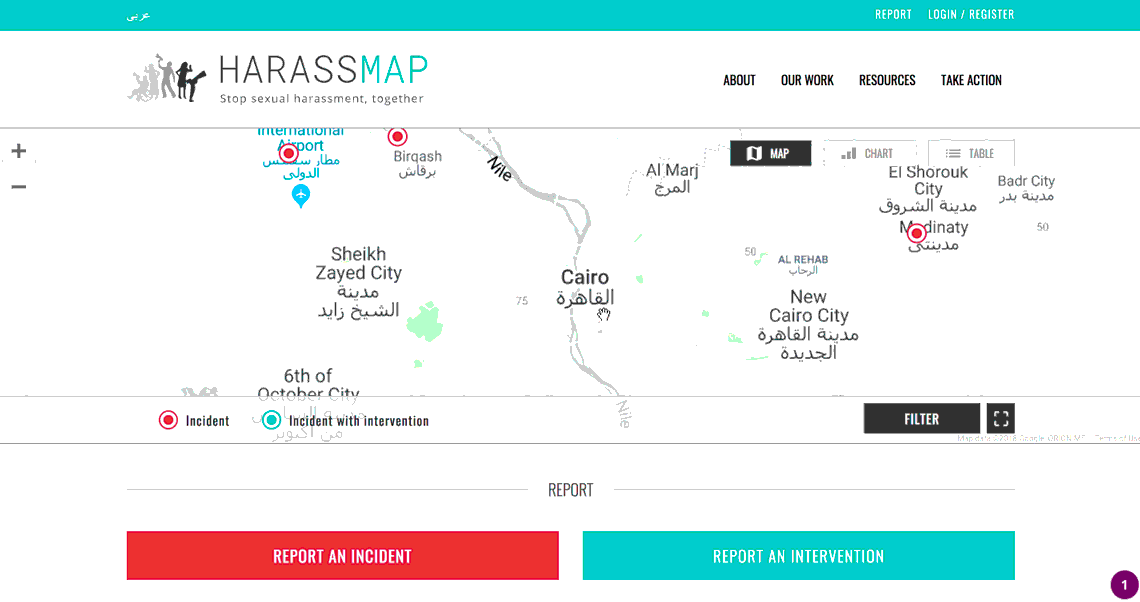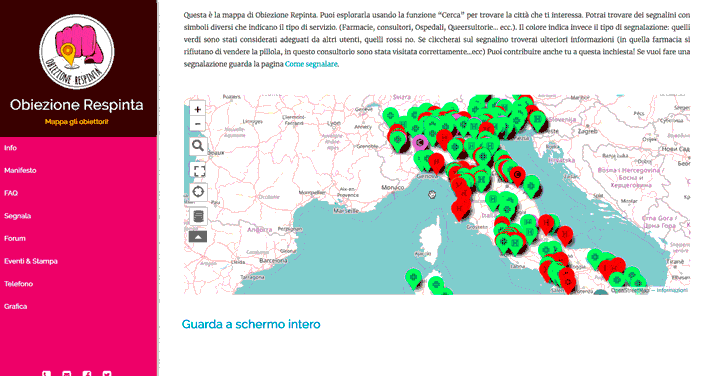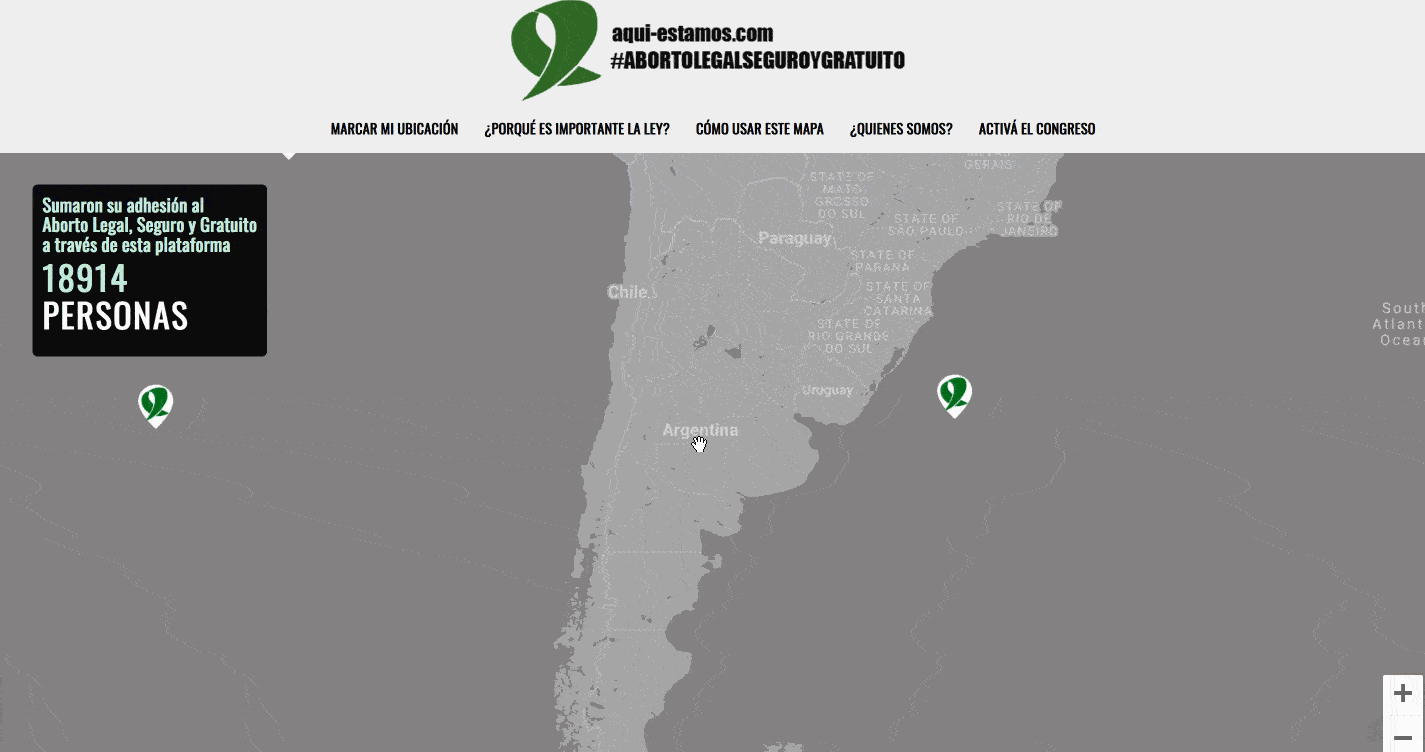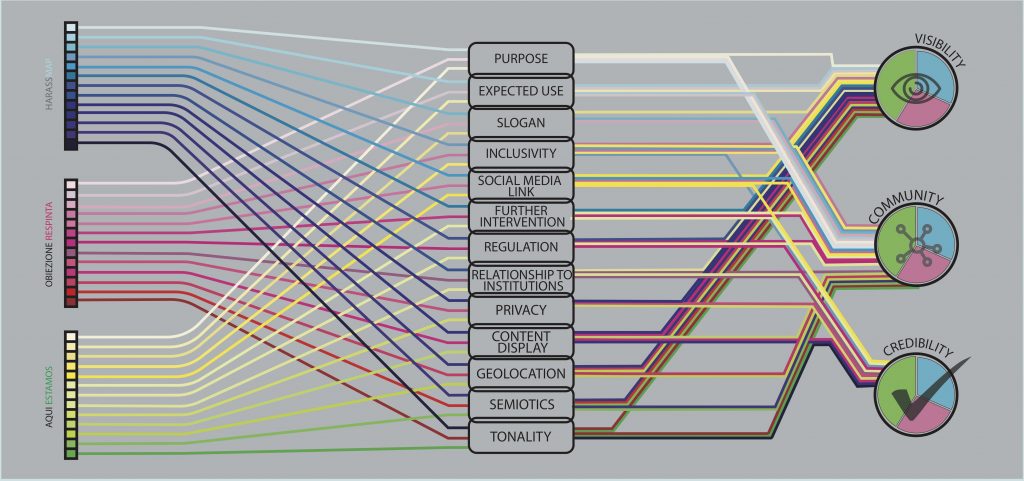“Grassroots Maptivism”: Mapping Feminist Movements Around the World
The virtual space has become the preferred place to demand for change. There are several examples of such movements from all over the world – Occupy Wall Street, The Arab Spring, #BlackLivesMatter, #NiUnaMenos #15-M Movement. With over 4 billion people (~52% of the world’s population) online and social media use on the rise in many countries, one could assume we would be witnessing the rise of big scale, global examples of digital activism by now. Aside from one or two possible examples, global movements remain to be seen. In fact, the majority of social movements remained tied to a local or regional level. In this context, the use of maps as tools for activism reveals itself as a key area to study how oppressed groups and minorities reclaim physical and virtual spaces. This ties in to whether the expansive abilities of their slogans and purposes match the globalizing capacities that mapping services afford.
Mapping the intersection between Activism, Feminism and Maptivism
Our project idea stemmed from the use of maps to promote causes related to women’s rights and feminism. We focused on what we call “maptivist” sites that require users to input information, thus the use of the term grassroot to illustrate the usage of collective-community action to effect change. Consequently, our study is located in the intersection of three key topics that have been extensively researched- grassroot movements, digital activism and feminism- additionally; we are focusing on a new media phenomenon that is still in its early stages: maptivism.
We concentrated on sites that were vocally feminist and/or dealing with women’s rights issues because when looking for maptivism initiatives online, it was evident that mapping tools were very popular among feminist consciousness-raising and activist efforts. From our search, we found that maptivism is preferred by these collectives as it allows the reclaiming of physical and virtual space, as well as has the potential to make visible the oppression that women and LGBTQI groups suffer in physical spaces.
Our study focuses on how the interfaces of feminist “maptivist” sites shape the user-contributor experience. Particularly, how their interfaces afford visibility, credibility and community building. The three dimensions are fundamental for activism online and offline. Visibility emphasizes how collective identities are represented and vocalized, whereas credibility is relevant in this debate because anything in association with the internet needs an element of reliability, especially in this day and age. Finally, community building illustrates bringing people together in relation to a cause, which exhibits a sense of unity.

HarassMap – Egypt

ObiezioneRespinta – Italy

Aquí-Estamos – Argentina
In order to have a varied perspective, we chose to study three cases in different parts of the world to compare their interface design and strategies. The first case we examined is the HarassMap, based in Egypt, which is used to report both incidents and interventions of sexual harassment. The second website established in Italy, ObiezioneRespinta, translates into “rejected objection.” It focuses on a dual-expected use: reporting places that deny or give women and LGBTQI people access to information or services on pregnancy prevention and abortion. The website also allows users to search for places near them that will provide such required services. Finally, Aquí-Estamos in Argentina, which translates to “here we are,” is used to allow people to pin their locations in order to show their support for a law legalizing abortion.
Plotting the Significance of Grassroot-Maptivism in Feminist Contexts
If the virtual and the physical world have a strong interconnection and can influence each other, then we would like to examine how activism practices, often associated with radically empirical experiences, can be placed in the virtual. As stated previously, the specific topic we want to discuss is “maptivism” and the way this tool is a perfect example of how the two worlds (virtual and physical) can communicate with each other. Virtual maps can be easily associated with the issue of control and privacy, but there are different experiences that make us think of a possible application of this technology to obtain an opposite result: a result of self-determination, of claiming a space that it is not only virtual but also physical.
The idea of self-determination is one of the main purposes of the three websites analysed and more broadly a cross-cutting theme in feminist movement. This claim for self-determination ties in with women’s and minorities’ demand to have agency over their own bodies, as well as to denounce the violence inflicted upon them. For example, in the cases of gender violence, feminist practices place a strong emphasis on the creation of common spaces, in which discriminated subjects can find refuge. What happens when these spaces become virtual as well? As we will see later, through the use of maps and blogs, internet sites become a fundamental tool for these kind of practices.
For this study, the relevance in this new approach is emphasizing the process of establishing a safe space through a new media object, such as an interactive map or a blog. In the last decades social media and microblogging have set up the basis to create a solid community sense even in the virtual. Poell and Van Dijck illustrate that online activism is characterized by abundant creativity of “intricate ways in which online and offline protest blend” (227). This leads to a creation of a “virtual social reality,” an integration of both worlds that enhances crowdsourcing (Rabie 20).
Tools like maps, social media or web infrastructures enable but also regulate activists’ interactions and content. Poell and Van Dijk recognize that channeling contestation and protest online requires that such expressions are structured by digital medias’ architectures. An analysis of the websites’ technological infrastructures and interfaces will allow us to present how these digital artifacts shape activist’s mobilization and identification rather than just carrying content (Poell and Van Dijck; Milan; Dolata and Schrape).
The analyses of the specific materiality of maptivist websites raises questions on how collective identities are constructed online and how visibility, that is, the “digital embodiment and online presence of individuals and groups and their associated meanings” (Milan 6), makes physical co-presence unnecessary for collective experience. Furthermore, we believe that these mapping sites create an element of authenticity due to the choice of inputting your data. However, they also create an issue of privacy and surveillance, because whether or not you choose to be anonymous you have already added to your “algorithmic identity” and that opens a window for control (Cheney-Lippold).
Taking into account the purposes of online activism, and more specifically the three feminist websites that we will analyze in this article, it is understandable that they focus their attention on obtaining self-determination in the virtual space. As a result, privacy issues for activism become an important scope of inquiry. In this sense, anonymity is of significance because while it affords a sense of security to users providing information to the mapping sites, it may mean compromising on building both visibility and credibility. However, our analysis suggests that the cases studied, have been able to create a degree of credibility even while extensively using anonymous reporting.
Around the World in Three Maps
In order to analyze the three websites, we used “the walkthrough method” suggested by Light et al. The method involves two main stages: looking at the sites context and imitating users’ employment of the site, in order to do a detailed analysis of the interfaces (Light et al.). Hence, we were able to identify the different visions, operating models and modes of governance while also examining the interface arrangements, functions, features, textual content and symbolic representations for each website. Comparing the websites allowed us to provide a detailed account of the intended purposes to be able to use their embedded cultural meanings to situate each case in relation to the three elements we are focusing on (Stanfill).
The interface of HarassMap.org is constructed in a way that maintains a balance in affording visibility, community sense and credibility. Action-oriented buttons, a ‘corporate’ tone and mention of its reach and recognition indicate a more organizational and non-political ethos. ObiezioneRespinta.info has a focus on community, resonating with the site’s dual expected use – of mapping “conscious objection”, as well as serving as a resource for those who may need these services. In fact, the nature of its central issue- “conscious objection” is very culturally contextual. Aquí-Estamos.com’s interface focuses on building visibility and community, seen in its association with social media and affiliation to larger women’s movements.
HarassMap’s rhetoric suggests its corporate-like ethos, for example the comprehensive ‘Terms of Use’ emphasizing it documents cases of harassment and is community moderated – claiming no liability in postings and no endorsement of third-party links on its pages. Therefore, it sets itself up as a “platform”, a neutral intermediary not responsible for the content on it (Gillespie). Action-oriented buttons like “get active” and “weekly tips” suggest what Morozov calls a “solutionist” ideology, one he believes offers narrow solutions to complex problems. ObiezioneRespinta’s rhetoric, represents a sharply political and anti-institutional stand, seen in section headers like “Manifesto” and in the frequent use of terms like “self-managed” and “we”, which shows how the site is for and from users-contributors.
These cases also differ in how they highlight inclusivity, with ObiezioneRespinta and Aquí-Estamos being particularly careful in their use of gender-neutral language and the inclusion of LGBTQI people. HarassMap shows men and women of different ages as well as people with disabilities, showcasing inclusion that is oriented to the Arab world. Aquí-Estamos’s use of the green scarf is also a considered choice, referencing Argentina’s history with the scarf which has become a potent symbol of women’s political agency and several movements; since it was first used by Mothers of the Plaza de Mayo. The symbol used by ObiezioneRespinta – a fist with black nail polish – portrays a counter-cultural perspective and the collective’s strength. Additionally, institutions that each site chooses to associate with also address their cultural specificities. HarassMap strikes a balance between academic, state and non-governmental; referencing national and international names. Whereas, both ObiezioneRespinta and Aquí-Estamos associate with prominent national feminist collectives.

In our analysis we operationalized our three dimensions of analysis – visibility, credibility and community building – in 13 words that allowed us to proceed with a thorough case-by- case study and to compare the three sites.
Regarding the use of social media platforms, some authors argue these have become “obligatory passing points” for channeling protest and indignation (Poell and Dijck 232). Two out of the three cases studied, however, shy away from encouraging the use of social media. Only Aquí-Estamos demands users sign-in through social media in order to pin their location and suggests they “share this map so many others can do the same”. This is in line with using the hashtag #AbortoLegalSeguroyGratuito as a slogan: Aquí-Estamos wants to be a part of a larger conversation that is taking place inside and outside social networks. This position is also evident in interventions suggested by the site, providing a link to “Activate the Congress” an initiative encouraging people to contact their representatives through twitter, and suggests that users attend demonstrations.
This combination of physical and online commitment is present in the other examples as well. In HarassMap, witnesses of sexual harassment are expected not only to report, but also physically intervene or, as the site calls it, “take action”. Similarly, but in its “anti-institutional” fashion, ObiezioneRespinta expects users to partake in the International Women’s strike and to acquire and share grassroot-sourced information about sexual and reproductive health. Thus, suggested interventions are not only culturally specific but also dependent on the sites’ political context.
The three sites used online maps to make visible oppression’s that occur in physical spaces. However, the choice of mapping services reveals their different priorities. While the Egyptian and Argentine sites chose to use Google Maps, a service that most users may be familiar with, ObiezioneRespinta used OpenStreetMap, an open source service created by “a large community of collaborators”. Decisions over what mapping service to use tie in with the rhetoric and cultural specificity of the three cases analyzed. Aquí-Estamos’ choice of an ubiquitous service makes sense in its pursuit to pin as many supporters as possible, while HarassMap’s choice of the platform ties in with its corporate language. ObiezioneRespinta’s use of an open data resource makes sense in the context of its anti-institutional and grassroot rhetoric. But service choice implications go beyond creating a more or a less subversive ethos: by avoiding Google Maps and social media and even allowing people to provide information telephonically to preserve their anonymity. ObiezioneRespinta goes a long way to protect its user’s data and privacy. Conversely, the use of social media and/or Google Maps by the other sites introduces mechanisms that allow users to be tracked, which is especially worrying when considering the sensitive topics these sites deal with.
Pinning the Key Implications for Maptivist Sites
As Poell and Van Dijk warn, the use of popular platforms is a double-edged sword and “online protest communication allows authorities to track activist activity” (Poell and Dijck 230). What came up in our analysis is that the use of tools such as Google Maps, Facebook and Twitter facilitate visibility and may be beneficial for building community and credibility. Only in some socio-cultural contexts like ObiezioneRespinta’s ideal community may the use of these commercial platforms be detrimental. In general, these platforms allow for “creative protest activities” and for accelerated visibility of social causes. However, when looking at these interfaces and practices, it is key to ask what is the cost of using these commercial platforms. Are these initiatives trading user’s privacy for more visibility? And if so, the consequences may be dependant on the socio-cultural and political context: while in some places the stakes may not be too high, in others authorities and opposing movements may be developing strategies to respond and counteract activist’s practices or even track and penalize users.
Grassroot maptivist tools have the potential to bring about change and help oppressed groups, as well as minorities reclaim physical and virtual spaces. But in order to do so, their interfaces have to build visibility, credibility and community in strategic ways. While the interface of HarassMap maintains a balance between the three dimensions and has a corporate tone that may be suitable for its cultural context in the Arab World, ObiezioneRespinta focuses on community building, which complements its dual expected use and the political context in Italy. Finally, the way Aquí-Estamos’ interface prioritizes visibility and community building, as well as its use of social media correlates with its goal to map as many supporters as possible for the legal abortion law in its home country. Thus, studying mapping sites makes evident how even now, when movements have the capabilities of being global through digitalization, movements and the interfaces created by them remain very much local.
References
Cheney-Lippold, John. “A New Algorithmic Identity: Soft Biopolitics and the Modulation of Control.” Theory, Culture & Society, vol. 28, no. 6, Nov. 2011, pp. 164–81. SAGE Journals, doi:10.1177/0263276411424420.
Dolata, Ulrich, and Jan-Felix Schrape. “Masses, Crowds, Communities, Movements: Collective Action in the Internet Age.” Social Movement Studies, vol. 15, no. 1, Jan. 2016, pp. 1–18. Taylor and Francis+NEJM, doi:10.1080/14742837.2015.1055722.
Light, Ben, et al. “The Walkthrough Method: An Approach to the Study of Apps.” New Media & Society, vol. 20, no. 3, Mar. 2018, pp. 881–900. SAGE Journals, doi:10.1177/1461444816675438.
Milan, Stefania. “When Algorithms Shape Collective Action: Social Media and the Dynamics of Cloud Protesting.” Social Media & Society, vol. 1, no. 2, July 2015, p. 2056305115622481. SAGE Journals, doi:10.1177/2056305115622481.
Poell, Thomas, and José van Dijck. “Constructing Public Space: Global Perspectives on Social Media and Popular Contestation — Introduction.” International Journal of Communication, vol. 10, no. 0, Jan. 2016, p. 9.
Rabie, Sara. “Crowd-Feminism: Crowdmapping as a Tool for Activism.” academia, 2013. p. 1-60. https://www.academia.edu/5045812/Crowd-Feminism_Crowdmapping_as_a_Tool_for_Activism. Accessed 1 Oct. 2018.
Stanfill, Mel. “The Interface as Discourse: The Production of Norms through Web Design.” New Media & Society, vol. 17, no. 7, Aug. 2015, pp. 1059–74. SAGE Journals, doi:10.1177/1461444814520873.



